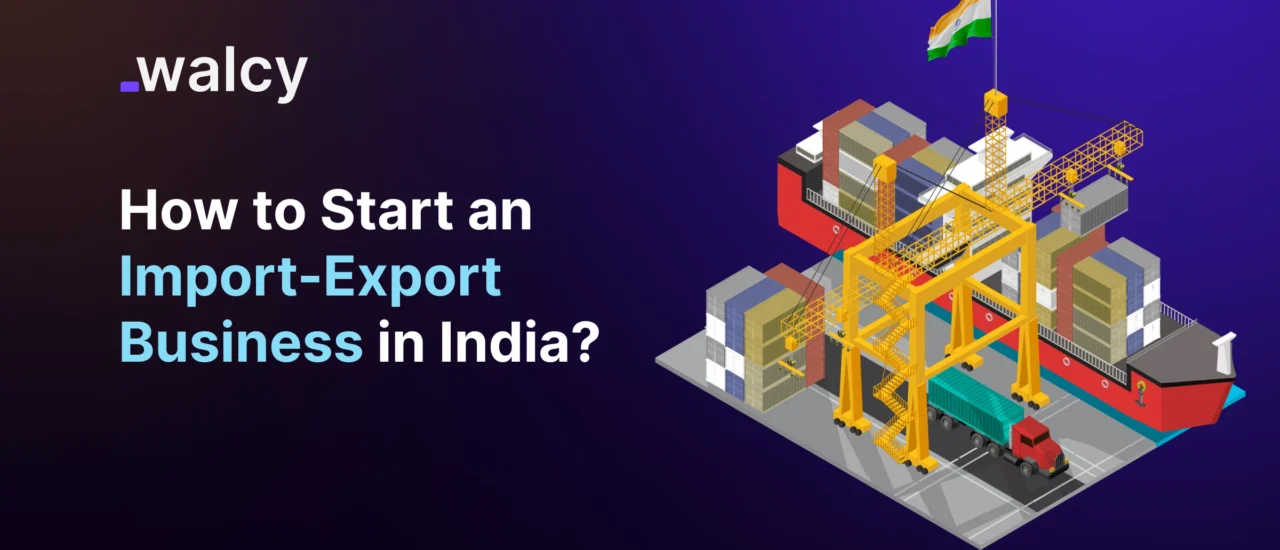India is a growing economy and offers enormous opportunities for doing business. Similarly, in the case of international trade, this holds good. If done in India, an export-import business can open your doors to various profitable opportunities as the country has emerged as a global trade hub. But again, it is just like any other business; one needs to be discrete regarding planning, understanding regulations, and approaching it in a structured way.
The tutorial will cover how to start an import-export business in India, the import and export procedure in India, the import-export business start-up cost in India, the possible profit margin that one can expect, and a short overview of import and export policy in India.
Understanding Import-Export Business
First things first, one must understand the import-export business’s concerns before getting into its step-by-step process.
Import refers to buying goods and services from other countries and bringing them to sell to the home country.
On the other hand, export refers to selling any product or service to another country.
International trade gives unlimited opportunities to Indian enterprises on world marketplaces; raw materials, finished goods, and new customers in every nook and corner of the world will be accessible.
Research And Business Planning
Essentially, good research about the market is first done before jumping into it; you need to find out the viable product and potential target market and competitors. Here is how to get initial research done:
Demand Products: You shall have to choose those products, which are in demand in the target foreign markets. This might be either trending or something related to the needs of the market. Samples of such exports from India include textiles, handicrafts, spices, and quite a good number related to electronics and machinery.
- Know Your Competitors: Understand all of your competitors local and international get an idea concerning their strategy.
- Target Market: In the case of exports, which target markets would you export your products to? Identify those countries. For imports- name those countries which produce the items that you want to bring into India.
The result of this study would be a business plan that, at the minimum should contemplate product, target markets, marketing strategies, cost analysis, and operational details.
Legal Requirements to Start an Import-Export Business in India
To set up an Import-Export business in India, you will have to fulfill all the legal formalities of the business as well as obtain various licenses from the concerned departments. This will require the following main steps:
Obtaining a PAN Card
You will be requiring a Permanent Account Number, which is an essential thing for any person undertaking business- Export-Import. In case you do not have one business PAN, you have to apply to the Income Tax Department of India with a PAN in your name.
Register Your Business
You will have to incorporate your venture by getting it registered as a legally recognized entity. You may choose proprietorship, partnership, LLP, or private limited company-whatever suits you best. Most of the businesses prefer incorporation as a private limited company for ease of compliance and scalability.
Importer Exporter Code (IEC)
IEC no. is required by every importer and exporter of the country. It is provided by the Directorate General of Foreign Trade, which becomes mandatory for every business to carry on business internationally. IEC can be applied online through the DGFT portal.
You shall love: What is an Import-Export Code (IEC): Why is it Important?
GSTIN: Goods and Services Tax Identification Number
After incorporation of business, you would need a GST. As you are an owner of an import-export business you shall be liable to furnish GST returns about the transactions between India. Thus, GST must be for allowing your organization to comply with the local tax law.
Read about: GST For Foreign Exchange Transaction? Must Know Things.
Foreign Exchange Bank Account
You open a current account with a bank authorized to deal in foreign exchange Category I bank, in short. All your foreign currency transactions arising out of the import-export business would be routed through this account.
Choose Product Classification (HS Code)
Each product that falls under international trade falls under an HS code. It ensures the right kind of duties and tariffs are implied and keeps a record of such products involved in international trade.
Import and Export Procedure in India
It is very important to learn the import and export procedures followed in India. All in all, here is how procedures go:
Export Process
Identification of the Product: Identify one such product that is in demand in the global market.
Find Overseas Buyers: Locate overseas buyers either at trade fares or through B2B marketplace sites or export organizations set up by your government.
Pricing and Quotation: Determine competitive pricing that should include the shipment cost customs duties and taxes.
Logistics: The contract of the forwarder is with a freight forwarder, who will contract for shipment. The supplier has to provide the export documents: an invoice, packing list, and shipping bill.
Customs Clearance: The customs clearance regarding the export of goods shall be done by the freight forwarder.
Receipt of Payment: The receipt of the payment shall be via a secured medium, such as Letters of Credit or online gateways of payment that offer fraud protection.
Read about: All About Overseas Payments (2024); Comprehensive Guide
Import Process
Product Identification to Import: The first step is to decide on the type of product that is to be imported and to determine if the product is in demand or can be demanded in the local market.
Identify Foreign Suppliers: Directly, through B2B marketplaces, or during international trade fairs.
Discuss Terms: Conclude on the price to be paid, quantity needed, terms of shipment, and mode of payment.
Customs Clearance: In the case of import, the consignment should clear Indian customs with the correct HS code. You will also have to pay the applicable import duties and taxes.
Paying the Supplier: Pay your foreign supplier in time using the safe methods of international transaction such as wire transfer or Letter of credit
Cost of Import-Export Business Start-up in India
Cost of importing and exporting business setup is going to vary profoundly depending upon the size and type of the operations. In its most basic form this is how certain costs would show up:
Business Registration and Legal Costs: Getting a PAN, IEC, GST registration, and business registration also can take anything between INR 10,000 to INR 50,000, depending on the complexity and services involved.
Initial Inventory: In the case of physical products, one will have to purchase initial inventory-a necessity which may range from a few thousand rupees to many lakhs according to the type of product.
Logistics and Shipping: Some major expenditures you are supposed to incur in the import-export business are international shipping, customs duty, freight charges, and so on. This depends upon the volume of merchandise; similarly, it would depend upon a country.
Marketing and Buyer Hunting: You may also invest in marketing through online channels, trade fairs, or B2B platforms. It may cost anywhere between INR 20,000-1 lakh.
Import-Export Business in India: Profit Margin
The profit margins are never uniform in the import-export business of India. It all depends on various factors such as the product, demand in the market, competition, and shipment cost. Generally, an export business can fetch up to 10 to 30% profit margins, depending on the industry or sector one operates in.
Market Conditions: Growing demand in overseas markets, especially for certain commodities, is surely going to attract handsome returns.
Operational Efficiency: Proper logistics and sourcing at cheap rates will surely bring a say in profit margins.
Government Incentives: There are a lot of export promotion schemes present in the country that may increase your margin and it includes the Merchandise Exports from India Scheme and the Export Promotion Capital Goods.
Import and Export Policy in India
Import and export policies in India are governed under the foreign trade policy framed by DGFT. The policy enumerates guidelines, incentives, and restrictions for international trade. Certain key elements have been listed herein under:
Restricted and Prohibited Goods: There is a genre of goods that either could be restricted or wholly prohibited to import and export, respectively, due to national security, environmental concerns, and other health-related prescriptions.
Export Promotion Schemes: Tax exemption and duty drawback are a few of the export promotion schemes available.
Trade Agreements: Free Trade Agreements inked with many nations negate or lessen the tariff on specific goods; therefore, acting as a boon in trade development.
Conclusion
Setting up an import-export business is a whole new world of opportunities unfolding in India, but one needs to be updated with the market, legal procedures, and operational challenges. Hence, the steps to be followed shall understand the Import and Export Procedure in India.
Keeping a close watch on start-up costs and run-up profit margins creates a lucrative enterprise in international trade. With the right strategy and execution, the global market opens before you.
Read more: Expanding Business Internationally: Must Know Things



